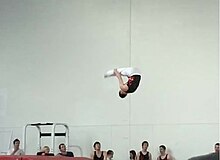Somersault

A somersault (also flip, heli, and in gymnastics salto) is an acrobatic exercise in which a person's body rotates 360° around a horizontal axis with the feet passing over the head.[1] A somersault can be performed forwards, backwards or sideways and can be executed in the air or on the ground. When performed on the ground, it is typically called a roll.
Etymology
[edit]The word 'somersault' is derived from Old Provençal sobresaut (via Middle French sombresault) meaning "jump over", from sobre, "over" (from Latin supra-, as in supranational); and saut, "jump" (from Latin saltus, the same root as salient).[2]
Types
[edit]

Body positions
[edit]Somersaults may be performed with different positions, including tucked, piked (bent at the hips), straddled, and layout (straight body).[3] Somersaults are often completed with twists.[4]
Direction
[edit]The sport of tumbling does not require participants to combine both front and back elements, and most tumblers prefer back tumbling as it is easier to build momentum.[5]
Arabian saltos begin backwards, continue with a half twist to forwards, and end with one or more saltos forwards. They can be trained by beginning with an Arabian dive roll and adding a front salto to it.[6] They are counted as front tumbling in women's artistic gymnastics[7] and back tumbling in men's artistic gymnastics.[8]
Multiple rotations
[edit]By 2003, the tucked double back salto had become common in women's gymnastics.[4] The triple back salto exists in men's gymnastics but was rarely competed until 2017.[9]
In 2019, American gymnast Simone Biles was the first woman to compete a back triple double: two saltos backwards with three twists in a tucked position.[10][11]
See also
[edit]- Aerial cartwheel
- Cartwheel (gymnastics)
- Roll (gymnastics)
- Trampolining
- Tumbling
- Parkour
- Handspring
- Diving
- Tumble turn
References
[edit]- ^ "Gymnastics 101: Glossary of Terms". USA Gymnastics. Retrieved 9 September 2015.
- ^ "somersault | Etymology of somersault by etymonline". www.etymonline.com. Retrieved 2024-08-02.
- ^ Cano, Victor (2018-12-03). "The movement of the arms in the somersaults". SYNKROLOVERS. Retrieved 2023-07-10.
- ^ a b Scientific Aspects of Women's Gymnastics. Karger Medical and Scientific Publishers. 2003. pp. 29–30. ISBN 978-3-8055-7476-1.
- ^ Jones, Henrique; Martinez, José (2022). "Running in Tumbling". The Running Athlete: A Comprehensive Overview of Running in Different Sports. Springer. pp. 151–152. ISBN 978-3-662-65064-6.
- ^ Brown, James Rollar; Wardell, David B. (1980). Teaching and Coaching Gymnastics for Men and Women. Wiley. pp. 400–401. ISBN 978-0-471-10798-9.
- ^ WAG COP 2022-2024 Section 7 Page 1
- ^ MAG COP 2022-2024, p. 39
- ^ "The Return Of The Triple Back Somersault In Men's Gymnastics". Deadspin. 3 October 2017. Retrieved 8 November 2022.
- ^ "The hardest floor skill yet to be performed? Jade Carey's triple-double". On Her Turf. 24 June 2021. Retrieved 25 October 2022.
- ^ Allain, Rhett. "The Twisty Physics of Simone Biles' Historic Triple-Double". Wired. Retrieved 25 October 2022.
